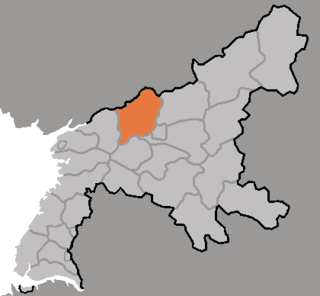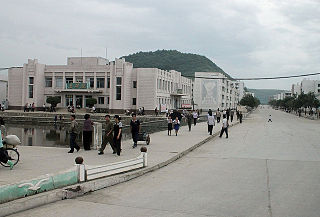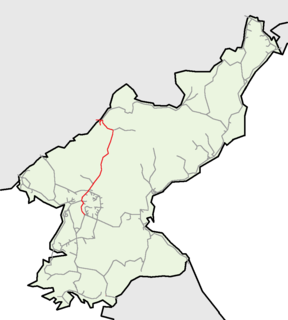Ch'ŏngch'ŏn'gang 청천강 | ||||||||||||||||
|---|---|---|---|---|---|---|---|---|---|---|---|---|---|---|---|---|
| Korean name | ||||||||||||||||
| Hangul | 청천강역 | |||||||||||||||
| Hanja | 淸 川 江 驛 | |||||||||||||||
| Revised Romanization | Cheongcheongang-yeok | |||||||||||||||
| McCune–Reischauer | Ch'ŏngch'ŏn'gang-yŏk | |||||||||||||||
| General information | ||||||||||||||||
| Location | Maengha-ri, Pakch'ŏn County, North P'yŏngan Province North Korea | |||||||||||||||
| Coordinates | 39°38′06″N125°36′20″E / 39.6349°N 125.6056°E Coordinates: 39°38′06″N125°36′20″E / 39.6349°N 125.6056°E | |||||||||||||||
| Owned by | Korean State Railway | |||||||||||||||
| Electrified | yes | |||||||||||||||
| Services | ||||||||||||||||
| ||||||||||||||||
Ch'ŏngch'ŏn'gang Station (Chosŏn'gŭl : 청천강역) is a signal halt in Maengha-ri, Pakch'ŏn County, North P'yŏngan Province, North Korea. It is on located on the P'yŏngŭi Line of the Korean State Railway, and is the starting point of the Kubongsan Line. [1] It is situated on the bank of the Ch'ŏngch'ŏn River, from which it gets its name.

The Korean alphabet, known as Hangul, has been used to write the Korean language since its creation in the 15th century by King Sejong the Great. It may also be written as Hangeul following the standard Romanization.

Pakch'ŏn County is a kun, or county, in southern North P'yŏngan province, North Korea. It is bordered to the north by T'aech'ŏn, to the east and southeast by Nyŏngbyŏn, and to the west by Unjŏn counties. To the south, it looks across the Ch'ŏngch'ŏn River at Anju city and Mundŏk county in South P'yŏngan province. In 1952, 4 myŏn of Pakch'ŏn were split off to join Unjŏn county; since then, the county's administrative divisions have been revised in 1954, 1956, 1958, 1978, 1980, and 1982.

North Pyongan Province, written before 1925 in English as Yeng Byen) is a western province of North Korea. The province was formed in 1896 from the northern half of the former P'yŏng'an Province, remained a province of Korea until 1945, then became a province of North Korea. Its capital is Sinŭiju. In 2002, Sinŭiju Special Administrative Region—near the city of Sinuiju—was established as a separately governed Special Administrative Region.




